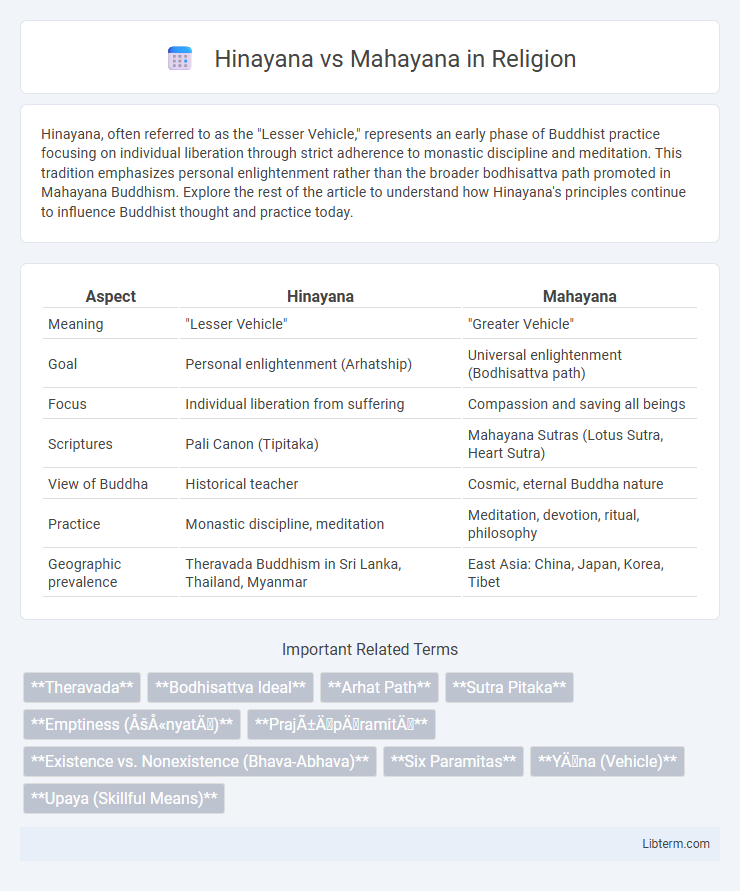Hinayana, often referred to as the "Lesser Vehicle," represents an early phase of Buddhist practice focusing on individual liberation through strict adherence to monastic discipline and meditation. This tradition emphasizes personal enlightenment rather than the broader bodhisattva path promoted in Mahayana Buddhism. Explore the rest of the article to understand how Hinayana's principles continue to influence Buddhist thought and practice today.
Table of Comparison
| Aspect | Hinayana | Mahayana |
|---|---|---|
| Meaning | "Lesser Vehicle" | "Greater Vehicle" |
| Goal | Personal enlightenment (Arhatship) | Universal enlightenment (Bodhisattva path) |
| Focus | Individual liberation from suffering | Compassion and saving all beings |
| Scriptures | Pali Canon (Tipitaka) | Mahayana Sutras (Lotus Sutra, Heart Sutra) |
| View of Buddha | Historical teacher | Cosmic, eternal Buddha nature |
| Practice | Monastic discipline, meditation | Meditation, devotion, ritual, philosophy |
| Geographic prevalence | Theravada Buddhism in Sri Lanka, Thailand, Myanmar | East Asia: China, Japan, Korea, Tibet |
Introduction to Hinayana and Mahayana
Hinayana, often referred to as the "Lesser Vehicle," emphasizes individual enlightenment through strict adherence to the original teachings of the Buddha, focusing on monastic discipline and meditation practices. Mahayana, known as the "Greater Vehicle," expands its path to include the liberation of all sentient beings by embracing compassion, the bodhisattva ideal, and a broader interpretation of Buddhist scriptures. These two main branches of Buddhism represent distinct philosophical approaches and practices but share core principles rooted in the Four Noble Truths and the Eightfold Path.
Historical Origins and Development
Hinayana, often associated with Theravada Buddhism, traces its origins to early Buddhist councils between the 3rd and 1st centuries BCE, emphasizing personal liberation through strict adherence to the Pali Canon. Mahayana Buddhism emerged around the 1st century CE in India, developing expansive scriptures such as the Prajnaparamita sutras and advocating the bodhisattva path aimed at universal salvation. The historical development of Mahayana introduced doctrinal innovations and widespread monastic institutions, contrasting with Hinayana's conservative preservation of early Buddhist teachings.
Core Philosophical Differences
Hinayana emphasizes individual enlightenment primarily through personal meditation and strict adherence to the original Pali Canon teachings, promoting the path of the arhat focused on self-liberation from samsara. Mahayana expands the ideal by stressing the bodhisattva path, where practitioners seek enlightenment not only for themselves but for all sentient beings, embracing compassion and the interdependence of all life. Core philosophical differences also include Mahayana's acceptance of new sutras and concepts like emptiness (sunyata) and buddha-nature, which challenge Hinayana's more conservative interpretation of early Buddhist doctrines.
Key Doctrines and Beliefs
Hinayana, often associated with Theravada Buddhism, emphasizes individual enlightenment through strict adherence to the Four Noble Truths and the Eightfold Path, focusing on the attainment of Nirvana by overcoming suffering and desire. Mahayana Buddhism expands on this by promoting the Bodhisattva ideal, encouraging practitioners to achieve enlightenment not only for themselves but also to aid all sentient beings, highlighting compassion (karuna) and the concept of emptiness (sunyata). While Hinayana stresses personal liberation, Mahayana incorporates broader philosophical teachings such as the emptiness of all phenomena and the interdependence of existence, which underpin its diverse practices and scriptures like the Prajnaparamita texts.
Approaches to Enlightenment
Hinayana, often associated with Theravada Buddhism, emphasizes individual liberation through strict adherence to the Noble Eightfold Path and meditation practices aimed at attaining Nirvana. Mahayana Buddhism advocates for collective enlightenment, encouraging the bodhisattva ideal where practitioners delay their own final enlightenment to assist others in reaching Buddhahood. The doctrinal difference highlights a more self-focused approach in Hinayana and a compassionate, community-centered approach in Mahayana.
Major Texts and Scriptures
Hinayana, often associated with Theravada Buddhism, primarily relies on the Pali Canon, also known as the Tipitaka, which includes the Vinaya Pitaka, Sutta Pitaka, and Abhidhamma Pitaka as its major texts. Mahayana Buddhism encompasses a vast collection of scriptures, with the Prajnaparamita Sutras, Lotus Sutra, and Avatamsaka Sutra being central to its teachings, emphasizing the Bodhisattva ideal and the concept of emptiness (sunyata). Both traditions place great importance on their respective canons for doctrinal guidance and practice, reflecting distinct historical and philosophical developments within Buddhism.
Practices and Rituals Compared
Hinayana practices emphasize individual meditation, strict adherence to monastic codes, and mindfulness aimed at personal enlightenment through the Four Noble Truths and Eightfold Path. Mahayana rituals include elaborate ceremonies, devotional chanting, and the veneration of bodhisattvas, highlighting compassion and the aspiration to achieve enlightenment for the benefit of all beings. Both traditions incorporate meditation but diverge in ritual complexity and the scope of spiritual goals, with Mahayana promoting collective salvation and Hinayana focusing on individual liberation.
Geographic Distribution and Influence
Hinayana Buddhism, often associated with Theravada, predominantly flourishes in Sri Lanka, Thailand, Myanmar, Cambodia, and Laos, shaping religious practices and cultures in these regions for centuries. Mahayana Buddhism spans East Asia, including China, Japan, Korea, Vietnam, and parts of Nepal, influencing art, philosophy, and social institutions through its diverse schools such as Zen and Pure Land. The geographic distribution highlights Hinayana's concentration in Southeast Asia versus Mahayana's extensive reach across East Asia, reflecting their distinct doctrinal developments and cultural integrations.
Notable Figures in Each Tradition
Hinayana, often associated with Theravada Buddhism, highlights figures like Gautama Buddha, who emphasized personal enlightenment through the Four Noble Truths and the Eightfold Path. Mahayana Buddhism features notable figures such as Bodhisattvas Avalokiteshvara and Manjushri, who embody compassion and wisdom, guiding practitioners toward universal salvation. Prominent teachers like Nagarjuna and Xuanzang further shaped Mahayana philosophy and practice through their extensive writings and translations.
Contemporary Relevance and Interpretations
Hinayana, often referred to as Theravada, remains influential in Southeast Asia, emphasizing individual enlightenment through monastic discipline and meditation practices. Mahayana Buddhism, prevalent in East Asia, incorporates a broader philosophical framework promoting the bodhisattva ideal and compassion-driven enlightenment accessible to all beings. Contemporary interpretations of both traditions influence global mindfulness movements and interfaith dialogues, highlighting their adaptive responses to modern ethical and spiritual challenges.
Hinayana Infographic

 libterm.com
libterm.com